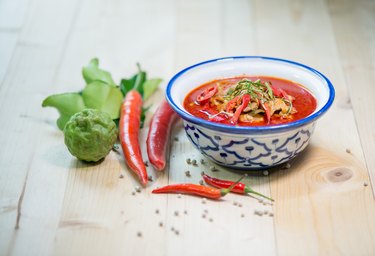
Chili sauces are almost infinitely variable in potency. Their heat can vary widely according to the peppers used, the cooking process and ultimately the freshness of your individual bottle. This makes it entirely too easy to accidentally take on more chili heat than you're comfortable with. If you're cooking with the chili sauce, there are ways to reduce its heat. If your finished dish is hotter than you'd like, there are also ways to minimize its impact at the table.
Replacement
Video of the Day
Many dishes that call for chili heat, either directly from chilies or indirectly from chili sauce, create a large quantity of sauce. If you've accidentally added substantially more heat than you're comfortable with, one way to address the problem is by removing and replacing part of the sauce. This is only an option if you have the time and ingredients to replicate the sauce, but can provide the best results. If necessary, strain out the solid ingredients from your sauce and allow the new batch to cook up on its own. When it's ready, return the solid ingredients to the pot and warm them in the sauce.
Video of the Day
Counter the Heat
Although replacing the sauce works well, it's seldom a practical option. It's usually more appropriate to add ingredients or flavors that will moderate the heat right in the dish. The two main alternatives, paradoxically, are sour and sweet ingredients. Tart flavors such as vinegar, lemon and lime, tamarind and tomatoes complement the heat and moderate it, which is why they're often combined in the world's cuisines. Sweetness is perceived by the same sensors in the brain as chili heat, so adding a small amount of sugar, honey or other sweetener to the dish will minimize its impact.
Relief at the Table
If your dish is ready to serve but you're uncertain of your guests' tolerance for chili heat, it's both prudent and considerate to have counter-measures close at hand. Dairy products are often used for the purpose, hence the spoonful of sour cream served alongside the food in many Mexican restaurants and the bowl of plain yogurt at Indian restaurants. Sweet or tart fruit-based condiments including Indian chutneys can moderate the burn, and so can chocolate. Cold beverages help, but avoid sodas and other carbonated drinks. Carbonation aggravates the effect of the chilies.
Physical Measures
Some effective responses to chili heat derive their effectiveness from their physical properties, rather than their effect on the taste buds. One of the most intuitive choices is also highly effective: When your tongue is burning, hold a piece of ice in your mouth. The chill from the ice deactivates the receptors on your tongue that perceive the chili heat. Dry, textured food items counter the burn by absorbing and rubbing away capsaicin, the oily substance that causes the chili burn. Breadsticks, crackers and other dry or crumbly foods work well. In a pinch, even a spoonful of sugar will do the trick.